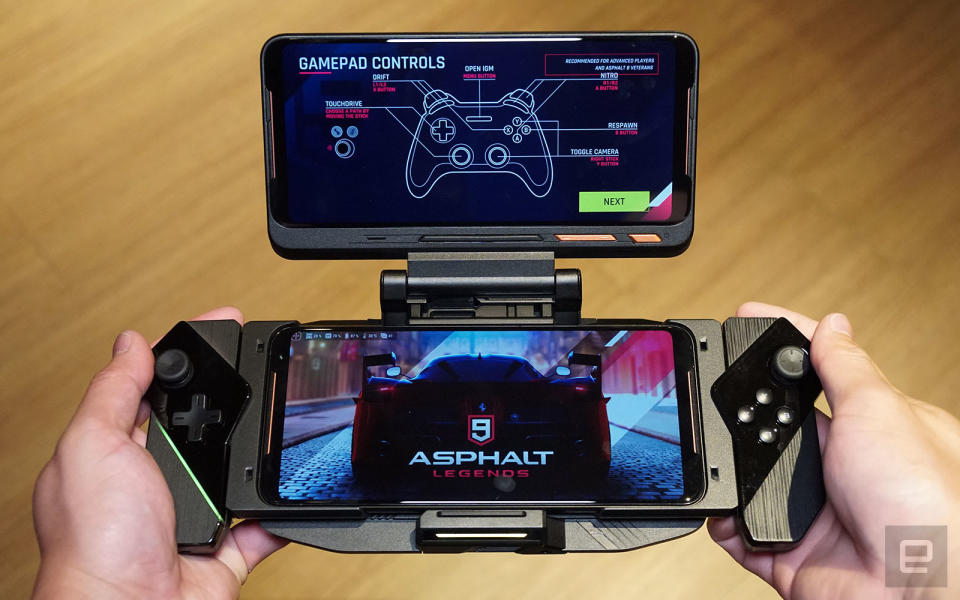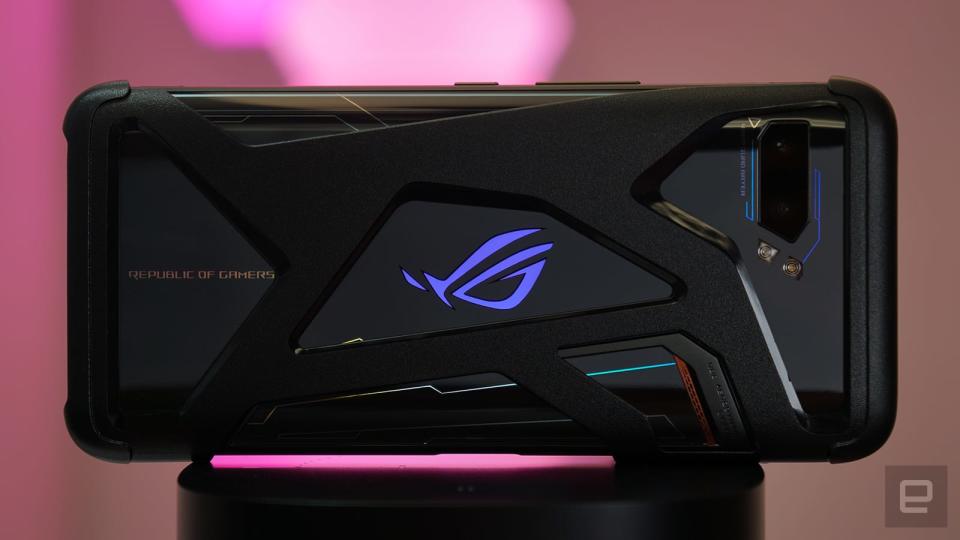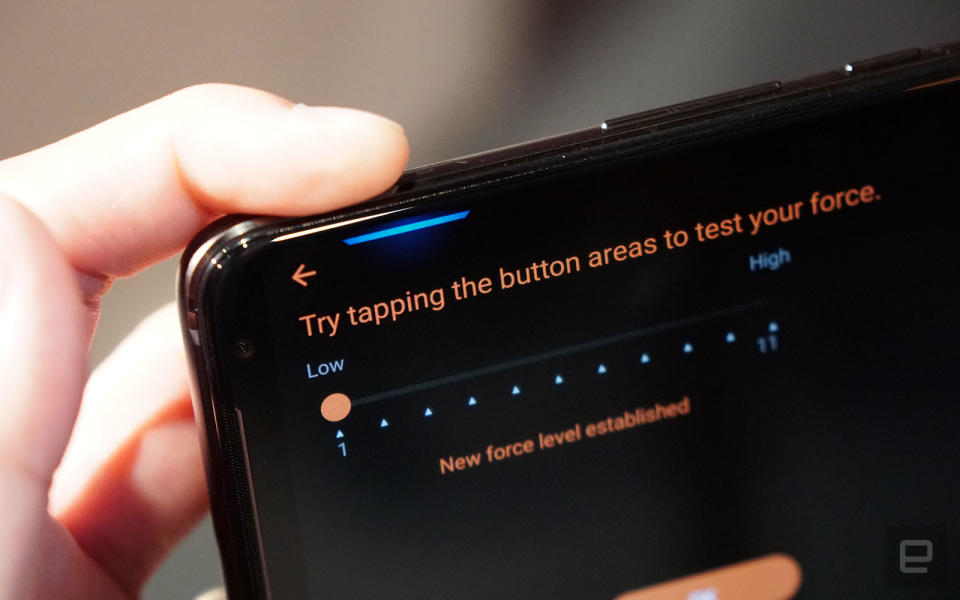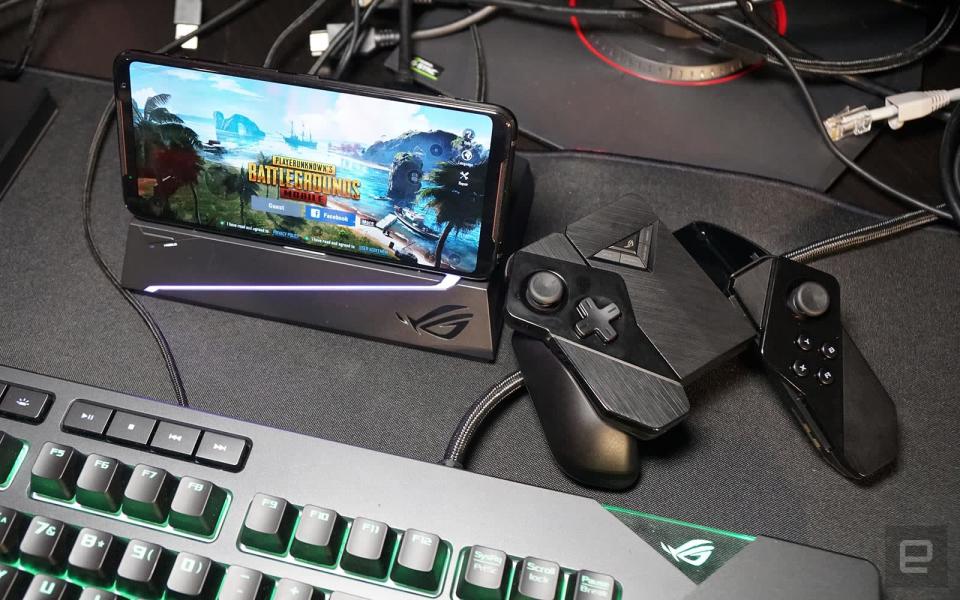ASUS' ROG Phone II combines high-spec power with accessory spectacle (updated)
With an updated dual-screen dock and Switch-like controllers, it's barely a phone.

Gaming phones are a rare breed, and the nascent category has already proved to be too much of a challenge for Razer. Some companies still see it as an opportunity to tap into the ever-growing esports market, however. Devices land with gimmicks like detachable controllers on Xiaomi's Black Shark 2, or a built-in cooling fan on the Nubia Red Magic 3. Neither could top last year's ASUS ROG Phone though when it comes to accessories: It offered a clip-on fan, a WiGig screen-casting dock, a clamp-on controller pad, a mobile desktop dock and a bizarre dual-screen dock.
ASUS never shared sales figures for the ROG Phone, but it must have done well enough to warrant a sequel packed with many upgrades. The ROG Phone II is the world's first smartphone with a 120Hz AMOLED display, and it's also the first to feature the more powerful Snapdragon 855 Plus chipset. Another first here is the integration of two vibration motors, just, it hopes. to make gaming a tad more immersive.
The most interesting part here is the accessories. The ROG Phone II still comes bundled with a clip-on fan (this still uses the phone's side port), but this new and improved AeroActive Cooler II is apparently four times quieter, and it can reduce the surface temperature by up to 5 degrees Celsius lower. Another included accessory is the skeletal Aero Case, which leaves the phone's glowing logo exposed, and it also lets you mount the clip-on fan over it.
What's brand new here is the ROG Kunai Gamepad, and ASUS clearly took a page out of Nintendo's book here. Say you have the phone propped up on a desk or you're casting to a TV, you can clip the two controllers together via a holder, in which you can toggle between Bluetooth, USB and 2.4GHz RF connection (there's a USB dongle receiver for this) to control the phone. If you're on the go, you can attach the controllers to the phone via a bumper (though the Black Shark 2 was the first to mimic the Switch this way); and you can even take the ultimate form by mounting this setup onto the new TwinView Dock II -- just be mindful of the whopping 639g total weight.

ASUS' new dual-screen TwinView Dock now mounts on the bottom side instead of the top, partly for better weight distribution and also partly for accommodating the device's extra length. The built-in touchscreen uses the same 120Hz AMOLED panel as the phone, though the built-in battery has been downgraded from 6,000mAh to 5,000mAh -- which is fine since you're still getting a larger 11,000mAh total capacity when docked.
The dock also packs a cooling fan, RGB lights, volume keys, a USB-C port and a headphone jack, but in order to drastically reduce weight, ASUS has removed the old SD card slot, extra speakers, trigger buttons and haptic vibrators here -- most of these are taken care of by the phone itself.
The other accessories are optional and, well, less interesting. Some markets will again offer the full kit in a limited edition carry-on suitcase. There's the same Mobile Desktop Dock that's compatible with both ROG Phone models, and this lets you share your PC monitor, keyboard, mouse and LAN connection with the phone -- just hit the dock's button and you can instantly switch over to some serious mobile gaming. You can also get the same old Pro Dock (basically a USB dongle with several essential PC sockets), plus a WiGig Display Dock Plus for casting your mobile screen to a TV over high quality, low latency wireless connections.
Of course, all these fancy features are meaningless if no games support them. ASUS announced three major titles -- Asphalt 9, Shadowgun War Games and Rockman X Dive -- that will come with optimizations as well as exclusive content tailored for the ROG Phone II. These optimizations are mostly to do with boosted frame rate, fine-tuned haptic vibration, Kunai Gamepad support and TwinView Dock II support (except for Rockman). ASUS will need to gather more support from games if it wants all its companion peripherals to make sense.

But back to the phone itself, which has also been given some substantial upgrades. The ROG Phone II features a 6.59-inch FHD+ (2,340 x 1,080) AMOLED panel, with its maximum refresh rate bumped from the earlier 90Hz up to an even smoother 120Hz. And yes, you have the option to scale back down to 90Hz or 60Hz to save battery. While it's true that the Razer Phones already had a 120Hz display, they were using LCD instead of AMOLED -- the ROG Phone II has a much nicer, more vivid screen.
As for battery, ASUS has thrown in a generous 6,000mAh cell this time, which is a big jump from the earlier 4,000mAh. Hence the new 9.48mm thickness and 240g weight. Neither figure bothered me during my hands-on, but it may be a different story after prolonged usage.
The bundled ROG HyperCharge adapter pumps in 30W of power using just a regular USB-C-to-USB-C cable, and while it takes about two hours to fully charge the phone, it can already reach 4,000mAh in just 58 minutes, which should already last you a day.
ASUS claims that, compared to the OnePlus 7 Pro's Warp Charge technology, its own implementation apparently offers longer battery life -- the cells don't swell as quickly, and likewise with their capacity degradation. That's something we'll have to check out for ourselves. Still, some may complain about the lack of wireless charging here.

The ROG Phone II is also the first to appear with the brand-new Qualcomm Snapdragon 855 Plus chipset, which has a faster 2.96GHz CPU and 675MHz GPU than the original Snapdragon 855.
Since this is a 7nm chip, it should generate less heat than the 10nm Snapdragon 845 in the original ROG Phone; plus you still have a vapor chamber, heat sink and air vents keeping the phone cool, so that the CPU is less likely to be throttled during gameplay. You're also getting 12GB of RAM and up to 512GB of super-fast UFS 3.0 storage. In case you didn't notice, it's one high-spec phone
As for photography, the ROG Phone II features the same set of handy cameras as the ZenFone 6, so you get a 48-megapixel f/1.79 main camera (up to 4K 60fps for video) plus a 13-megapixel 125-degree ultra-wide camera. For selfies and (more importantly with this phone) livestreams, you'll be relying on a separate 24-megapixel front camera.
Despite the mobile industry favoring all-screen designs, the ROG Phone II still has some bezel at the top and bottom, and that's intentional. ASUS says it needs to keep these spaces for a better landscape grip without affecting gameplay. On a related note, the screen also has an ultra-low touch latency thanks to its rapid 240Hz touch sampling rate, keeping touch-gaming responsive and smooth.

Shoulder triggers have become a standard feature among gaming phones and ASUS' updated "AirTriggers" have a faster haptic response rate on the ROG Phone II, and you no longer have to raise your fingers before tapping. Best of all, you can now apply sliding gestures here to map more on-screen actions.
These can be customized in ASUS' "Armoury Crate" app, where you can also activate "X Mode" (it boosts hardware performance and clears background apps), launch games and tweak other gaming-specific features. The lower AirTrigger also serves as a squeeze trigger when holding the phone in portrait: you can set both short squeeze and long squeeze to toggle an app or action.
Audio has also been upgraded. The original triple-mic arrangement has been upgraded to four microphones for better noise cancellation, so your teammates or viewers can hear you loud and clear. Similarly, the front-facing stereo speakers are louder, thus making their DTS: X Ultra surround sound effect more immersive.
With online gaming, connectivity is arguably king, so ASUS has packed in a quad-antenna design to ensure optimal Wi-Fi reception, no matter which way you hold the ROG Phone II. In contrast, the Samsung Galaxy S10+ only has two WiFi antennas, which can be obscured by your hands when the device is held in landscape, affecting latency and your wins.

ASUS wasn't quite ready to share prices for the ROG Phone II just yet, but we do know that the China version will be launched in partnership with Tencent this month. Western markets will get a different version some time in September. The original ROG Phone started at $899, but chances are this new model will cost more given the more aggressive specs, so be prepared for some serious damage to your piggy bank, especially if you're eyeing on the full suitcase kit.
Update 7/22/19 8:37AM ET: The ROG Phone II will be launching in Taiwan on August 1st, and it'll cost NT$26,990 which is about US$870. That's a notable drop from last year's NT$31,990 or about US$1,030, so expect a similar gap in other markets. The TwinView Dock II is priced at NT$6,990 or about US$230, and the Kunai gamepad is asking for NT3,990 or about US$130.

